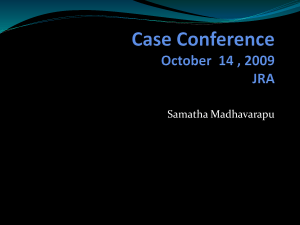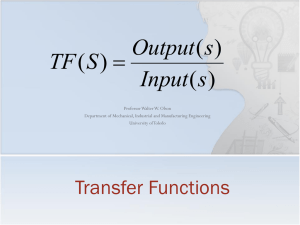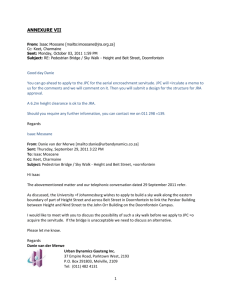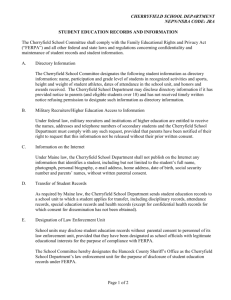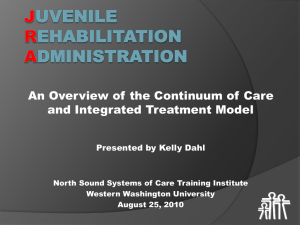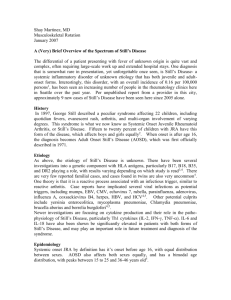VARIATION IN SYNOVIAL TISSUE EXPRESSION PATTERNS
advertisement
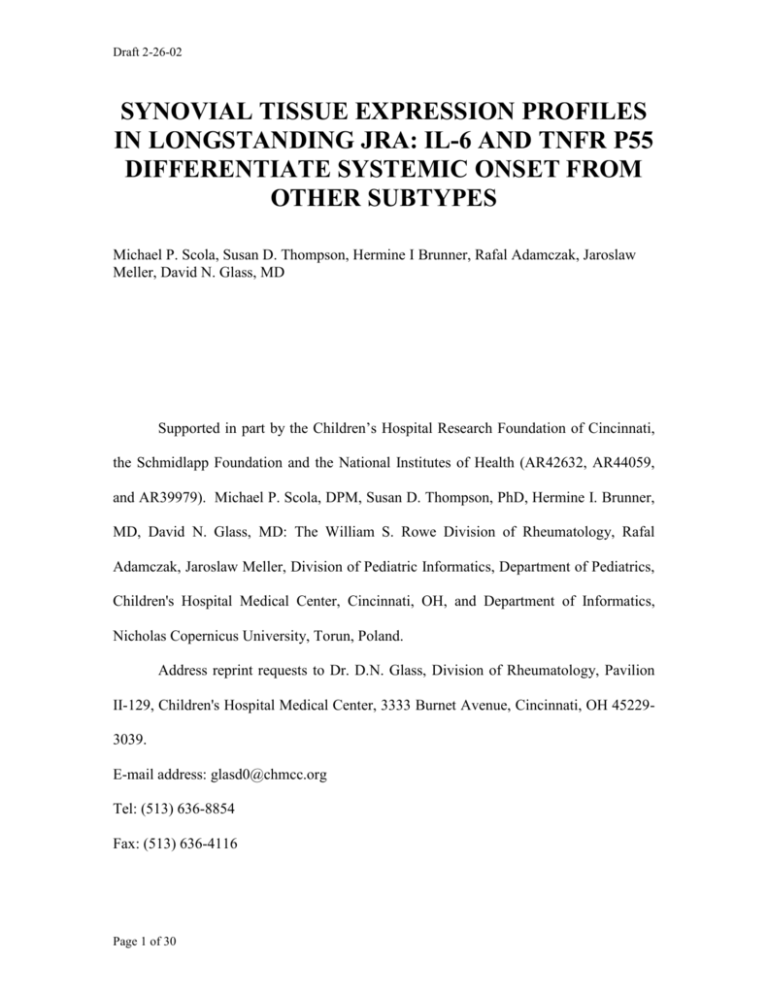
Draft 2-26-02 SYNOVIAL TISSUE EXPRESSION PROFILES IN LONGSTANDING JRA: IL-6 AND TNFR P55 DIFFERENTIATE SYSTEMIC ONSET FROM OTHER SUBTYPES Michael P. Scola, Susan D. Thompson, Hermine I Brunner, Rafal Adamczak, Jaroslaw Meller, David N. Glass, MD Supported in part by the Children’s Hospital Research Foundation of Cincinnati, the Schmidlapp Foundation and the National Institutes of Health (AR42632, AR44059, and AR39979). Michael P. Scola, DPM, Susan D. Thompson, PhD, Hermine I. Brunner, MD, David N. Glass, MD: The William S. Rowe Division of Rheumatology, Rafal Adamczak, Jaroslaw Meller, Division of Pediatric Informatics, Department of Pediatrics, Children's Hospital Medical Center, Cincinnati, OH, and Department of Informatics, Nicholas Copernicus University, Torun, Poland. Address reprint requests to Dr. D.N. Glass, Division of Rheumatology, Pavilion II-129, Children's Hospital Medical Center, 3333 Burnet Avenue, Cincinnati, OH 452293039. E-mail address: glasd0@chmcc.org Tel: (513) 636-8854 Fax: (513) 636-4116 Page 1 of 30 Draft 2-26-02 Objective. Systemic onset JRA (sJRA) differs from other onset types (oJRA) in clinical presentation and cytokine expression, yet late in the disease process the clinical appearance of the joint appears similar. We sought to determine if differential synovial expression patterns exist between sJRA and oJRA onset types even in the late stages of joint disease. Methods. Synovial tissue expression levels for 69 genes were determined for 17 sJRA and 26 oJRA patients via ribonuclease protection. Gene expression patterns were analyzed through use of pattern recognition methods. Estimates of statistical significance of the decision borders were derived by cross-validation and independently by adopting localized Gaussian density estimators of the Feature Space Mapping (FSM) method [2]. Results. IL-6 was significantly higher (p≤0.05), while IL-18, CCR2+, CX3CR1, GPR1 (p≤0.05), M-CSF and TNFRp55 (p≤0.01) were lower in sJRA compared to oJRA patient synovial tissue. CCR5 and IL-1, the membrane bound form of IL-1, displayed a trend toward higher levels in sJRA that did not reach significance (p<0.1). A simple logical rule derived using a decision tree algorithm allowed differentiation of sJRA from oJRA with relative confidence (p≤0.16) based on levels of IL-6, TNFRp55 and CCR7. Conclusions. Expression differences are apparent between sJRA and oJRA even in the later stages of joint disease. Identification of disease specific expression patterns allows for insight into disease pathogenesis and the development of rational targeted biologic therapy. Pattern recognition methods could potentially be useful in defining measures of disease outcome and severity when studying patients earlier in the disease course. Page 2 of 30 Draft 2-26-02 Juvenile rheumatoid arthritis (JRA) is a heterogeneous disease classified into several subtypes based in part on clinical features at the time of onset as well as course of disease [Cassidy, 1986 #79]. This clinical based classification, although accepted in North America, is not used within Europe where the current appellation is juvenile chronic arthritis, recently a more complex classification with 7 subtypes collectively called juvenile idiopathic arthritis has been introduced under the auspices of ILAR. These classifications rely more on clinical than biological markers although immunopathological differences exist between subtypes including genetic markers, especially HLA, and cytokine expression [Grom, 1994 #96][De Benedetti, 1997 #73]. Cytokines play a crucial role in the pathogenesis of autoimmune diseases, with a loss of regulation between pro- and anti-inflammatory mediators deemed crucial in the progression of disease. Variation in cytokine and cytokine receptor expression may impact disease pathogenesis, the clinical phenotype and outcome in JRA, which can range from self-limited, pauciarticular disease to severe disabling polyarticular disease [Murray, 1996 #37][Murray, 1998 #36]. Cytokines and their receptors have been correlated with clinical features in JRA outcome [Mangge, 1998 #51]. For example, during acute episodes of fever in systemic onset JRA (sJRA) serum IL-6 levels are elevated, with IL-1ra peaking approximately an hour later, presumably from IL-6 induction [Tilg, 1994 #104][Ozen, 1997 #148][Kutukculer, 1998 #56]. Similarly, TNF receptors have been shown to be elevated in JRA serum compared to controls, correlated to disease activity and anti-TNF therapies have been used in the treatment of polyarticular JRA with generally good results [Gattorno, 1996 #57][Lovell, 2000 #163]. Patients with systemic features only are not usually given DMRD therapy as is the case in destructive joint disease, a common Page 3 of 30 Draft 2-26-02 phenotype in systemic, polyarticular or pauciarticular onset patients. The development of rational biologic therapy to modify the course of disease will rely heavily on knowledge of disease specific gene expression patterns, especially in the site of long-term tissue destruction, i.e. the synovium. Most cytokine expression studies in JRA have been performed using peripheral blood or synovial fluid, with fewer studies of synovial tissue. The study of synovial tissue, as the target organ in the joint destructive process, may be the most relevant in terms of disease pathogenesis and eventual outcome. This is especially so in systemic disease where only a proportion of patients progress to severe destructive arthritis. Accordingly we have examined cytokine and cytokine receptor expression patterns in JRA patients synovial tissues for biomarker differences between systemic and other onset JRA types. At the stage tested, the patients had a polyarticular course and similar joint findings on exam. Patients and Methods. Patients. Synovial tissue was used from 17 systemic onset and 26 other JRA onset type patients, many of which have been previously described all but 2 having a polyarticular course [Scola, 2002 #268][Scola, 2001 #278] (Table 1). All JRA patients fulfilled the American College of Rheumatology criteria for diagnosis of JRA requiring arthroscopic or open synovectomy, diagnostic biopsy or joint replacement surgery as a normal part of clinical care. Tissue specimens, which would have been otherwise discarded, were snap frozen in liquid nitrogen immediately after surgery and stored at 70oC until used. All patients were followed at either the pediatric rheumatology clinics of Cincinnati Children's Hospital Medical Center, Cincinnati, OH, or the University of California, San Francisco, CA. Page 4 of 30 Draft 2-26-02 RNA isolation. Total cellular RNA was isolated from synovial tissues after homogenization with a Polytron Tissue Tearor (Biospec Products, Bartlesville OK) in appropriate volumes of RNA STAT-60 (Tel-Test, Friendswood, TX) according to manufacturer instructions. RNA concentration was determined by spectrophotometry. Ribonuclease protection assay. The RiboQuant™ Multi-Probe RNase Protection Assay (RPA) (Pharmingen, San Diego, CA) kits hCD-1, hCK-1, hCK-2, hCK3, hCK-5, hCR-5, hCR8, hANGIO-1 and custom Kits including TNFRp55, TNFRp75, IL-1RI, IL-1RII, MIP-3, MIP-3, CCR6, CCR7, CXCR3, IL-18 and IL-18R were used to generate antisense RNA probes as previously described [Scola, 2002 #268]. Briefly, the 32P-UTP-labeled probes were hybridized to 5 g of total RNA from each tissue (56oC, 16 hours), treated with RNase A+T1, and purified. The resulting protected probes were visualized following denaturing gel electrophoresis (5% acrylamide) by PhosphorImage analysis using a Storm 840 and ImageQuant software (Molecular Dynamics, Sunnyvale CA). An adjustment for signal intensity was made based on the number of 32P-UTP incorporated into each probe. Statistical analysis. Comparison of expression levels from patients with systemic versus other JRA onset types were made using Students t-Test. In order to account for non-normality of the gene expression levels distributions, the non-parametric Wilcoxon test was used to validate further the results of the t-Test analysis. The results of the non-parametric test were not significantly different and therefore only the results of the t-Test analysis are reported in the Results section. A p-value of ≤0.05 was considered significant. Pattern recognition analysis. Further and more detailed analysis of the data is performed using a number of widely used pattern recognition methods [9], such as the Page 5 of 30 Draft 2-26-02 c4.5 decision tree [8], Support Vector Machine (SVM) [1,7] and k-Nearest Neighbors (kNN) [3] methods. A more detailed description of the methods used here is included in the Appendix. The general goal is to find a subset of genes that best discriminate between different types of JRA and to formulate simple criteria that allow one to distinguish JRA of a specific type, based on expression levels of these genes. The present analysis extrapolates from a very limited sample of patients. Therefore, the consensus of different pattern recognition methods, that capture the underlying structure of the data using different criteria, is employed to validate additionally the results and to enhance their statistical confidence [4]. Boundaries of different classes (e.g. sJRA) are defined in terms of combinations of expression levels for several genes that best characterize a given onset type (see Figure 1). Following the common practice, the quality of such decision borders is estimated using a cross-validation procedure that consists of splitting the training set of all the patients in the study a number of times and using one subset as a training set and the other subset as control [1,2,3]. The average accuracy of classification of points not included in the training is used to estimate the generalization of the model (note that perfect learning on the training set may lead to over-fitting and poor generalization [4]). Because of very small size of the training set the cross-validation is limited to the socalled leave-one-out (L-O-O) procedure, in which only one point at a time is excluded from training. In light of the limited number of patients in the study, we computed an alternative estimate of the variability in the data, based on analytical approximation to the observed distribution of expression levels for relevant genes. The analytical probability density estimators are defined as a sum of separable Gaussian functions that are Page 6 of 30 Draft 2-26-02 integrated over decision regions to provide probability of observing certain expression levels given the type of JRA onset (see Appendix for details). Due to various constraints, for some patients the expression levels were not measured for all the genes considered in this study. Genes with data for less than 65% of the patients were excluded from the subsequent analysis. For the remaining 15 genes (i.e. IL-2, IL-6, IL-10, IL-15, I 309, FLK1, IFN-, LT-, LTN, TNF-, TGF-3, TNFRp55, CCR7, CD45, CXCR3) the still missing values are effectively neglected or estimated based on the neighboring data points. A further selection of genes that best discriminate types of JRA is performed in conjunction with the L-O-O procedure. As a result, each of the pattern recognition (classification) methods works in a different subspace of the initially selected 15 genes. In addition, a slightly different initial set of 15 genes (with IP10, CCR2b and CCR5 replacing LT-, TNF- and TGF-3) was selected (using the same criteria) for the problem of JRA vs. control group classification. Results Synovial tissues from up to 17 sJRA and 26 oJRA patients were examined (Table 1). RNase protection assays were used to determine mRNA levels and measurements were adjusted for loading differences by normalizing to GAPDH levels, thus allowing sample to sample comparisons. Previous studies using these same tissues have shown a predominance of Th1 related cytokines, chemokines and their receptors (ref). These (studies) receptors did not include either an analysis of the pro-inflammatory cytokine IL-6 + Th1 or on examination of disease subtype differences. Due to the limited amount of tissue available for study, each assay did not examine same number of tissues. Page 7 of 30 Draft 2-26-02 Expression of IL-6 an IL-1 and their receptors in JRA. Two cytokines, and their receptors, IL-6 and IL-1 differentiated at least in part systemic JRA disease and synovium from others. Previous studies have linked high levels of IL-6 expression, often correlating with disease activity, to systemic JRA [de Benedetti, 1991 #286][Ozen, 1997 #148][Mangge, 1998 #51]. Our data revealed greater levels of IL-6 in sJRA (n=15) than oJRA (n=20) (Figure 1), however, the expression of its receptor subunit, IL-6R, appeared similar in the two groups (1.856 ± 0.258, n=15 vs 1.835 ± 0.225, n=12). Further examination of IL6 levels by JRA onset type revealed that the pauciarticular onset patient tissue levels (0.582 ± 0.325, n=12, p<0.1) trended lower than that of systemic onset, with polyarticular onset (0.690 ± 0.281, n=8) intermediate between the two. Analysis of mRNA levels revealed a nearly two fold median increase in sJRA (n=10) levels of IL-1(0.06 to 0.03)and IL-10.229 to 0.105) over oJRA (n=16), yet the difference was not statistically significant with IL-1a exhibiting a trend toward higher levels (p<0.1). However, IL-1 was more highly expressed in sJRA (0.068 ± 0.018, n=10) than polyarticular onset patients (0.026 ± 0.006, n=8, p=0.049). IL-1RA did not significantly differ between the two groups. In addition, there were no differences noted in the expression of either IL-1RI (sJRA mean ± SEM vs oJRA mean ± SEM 2.560 ± 0.996, n=7 vs 2.335 ± 0.396, n=9) or IL-1RII (0.546 ± 0.190, n=7 vs 0.313 ± 0.057, n=9). Expression of TNFRP55 in JRA. No difference in the synovial tissue expression of TNF- was found between systemic onset JRA (sJRA) and other JRA onset types (oJRA). In contrast, sJRA (n=15) expression of TNFRp55 was significantly lower than oJRA (n=14)(Figure 1), even when compared to only polyarticular JRA (11.953 ± 2.305, n=4, p=0.003) or pauciarticular JRA patients (8.538 ± 0.871, n=10, Page 8 of 30 Draft 2-26-02 p<0.05). In contrast, TNFRp75 expression differences between sJRA (n=14) and oJRA (n=13) did not reach statistical significance. Another ligand capable of binding the two TNF receptors, lymphotoxin- (LT-), did not differ between sJRA and oJRA. However, sJRA expression of LT- was lower than that of the few polyarticular onset JRA patients examined (0.984 ± 0.193, n=15 vs 2.209 ± 0.406, n=3, p=0.019). Because IL-1 and IL-6 are related to macrophages, we studied other related mediators. M-CSF is a growth factor important in the proliferation, differentiation and survival of macrophages and therefore may play a role in chronic inflammatory responses such as found in JRA. sJRA (n=13) levels of M-CSF were significantly lower than that of oJRA (n=11) as shown in Figure 1, particularly when only pauciarticular JRA patient tissues compared (2.223 ± 0.296, n=13 vs 5.786 ± 0.673, n=8, p=0.0001, respectively). Though potentially reflective of the differences in M-CSF levels, no correlation was seen with CD14 in any onset group or when all tissues were combined. IL-18, largely produced by macrophages in the joint, was also significantly less expressed in sJRA than oJRA (n=10 and n=13, respectively), however IL-18R (0.089 ± 0.035, n=10 vs 0.046 ± 0.007, n=13) levels were similar in both groups. The difference in IL-18 expression was most evident between sJRA and polyarticular onset patient tissues (0.163 ± 0.047, n=10 vs 0.406 ± 0.060, n=5, respectively, p=0.009). Other cytokines, chemokines and receptors differentiating systemic from pauci and polyarticular disease. We also examined expression of the monocyte marker CD14 and found decreased levels in sJRA compared to oJRA (20.092 ± 3.742, n=9 vs 39.397 ± 4.500, n=9, respectively). This tissue expression difference was still seen when sJRA was compared to just polyarticular JRA (45.202 ± 7.906, n= 4, p=0.007) or pauciarticular JRA patients (34.753 ± 4.769, n=5, p=0.035). In contrast, no statistically Page 9 of 30 Draft 2-26-02 significant differences were noted in the levels of the T-cell markers CD3 or TCR- tested on the same time on that assay. Comparison of chemokine and chemokine receptor expression levels. Because chemokines can play a large role in the recruitment and retention of leukocytes, we examined the expression of several chemokines and chemokine receptors. CCR2 is a dimeric receptor comprised of independently regulated alpha and/or beta subunits resulting in either a homodimeric or heterodimeric functional combination. Our data showed a significantly lower expression of a sequence common to both the alpha and beta subunits of CCR2 in sJRA (n=9) compared to oJRA (n=9) patient synovial tissues (Figure 1). The fractalkine receptor, CX3CR1 (sJRA and oJRA n=13) and the orphan chemokine receptor GPR1 (sJRA n=12 and oJRA n=14) were both noted to be less expressed in sJRA tissues. The greatest difference in expression of CX3CR1 was between sJRA and polyarticular onset JRA (0.177 ± 0.047, n=15 vs 0.237 ± 0.061, n=6, p=0.025). CCR7, though no statistically significant differences were noted between sJRA and oJRA, was expressed less in sJRA when compared to polyarticular onset JRA (0.467 ± 0.113, n=16 vs 1.023 ± 0.217, n=5, p=0.029). Results of pattern recognition methods. The results of three different pattern recognition methods, namely the c4.5 decision tree, the Gaussian kernel Support Vector Machine (SVM) and k-Nearest Neighbors (k-NN) methods are summarized in Table 2 and Figure 1. The overall accuracy of classification for each JRA onset type vs. other types, which is reported in Table 2.A, is defined as the average percentage of correctly classified cases from both classes in the L-O-O cross-validation, disregarding the accuracy within each class. Table 2.B reports the results of classification within each class. For example, the overall high accuracy for classification of polyarticular JRA vs. Page 10 of 30 Draft 2-26-02 oJRA is largely due to correct classification of non-polyarticular (systemic and pauciarticular) cases, with very poor recognition of polyarticular cases (compare Table 2.A and 2.B). Note, that the accuracy of classification on the training set of all patients (see Table 2.B) is higher than the results after cross-validation, but it is less informative as to the generalization of the decision borders. For example, the SVM method recognizes correctly 39 (15 sJRA and 24 oJRA) out of 43 cases in the sJRA vs. oJRA classification, thus achieving approximately 91% overall accuracy as opposed to 81% in L-O-O cross-validation. The latter number provides, however, an estimated accuracy of classification for new cases, not included in the training. Using the accuracy of the decision borders for each class (and not only the overall accuracy) and consistency of the results from different methods as an additional criterion, the systemic onset type appears to be most uniquely defined in terms of the expression levels of genes considered in this study. We focus on the classification of sJRA vs. oJRA using the c4.5 method. Decision trees use linear decision borders, which are in general less accurate but are easiest to understand and visualize. SVM and k-NN achieve higher accuracy using non-linear decision borders, but a linear extrapolation from such a limited set of points may be in fact a safer choice in terms of generalization. Therefore, we regard the c4.5 results as more realistic in this case. In general agreement with the results of simple statistical analysis presented before, TNFRp55, IL6 and CCR7 genes are found to be most important for distinguishing sJRA from oJRA by the c4.5 algorithm. A simple rule: IF (TNFRp55 < 7.9 AND (IL6 > 0.6 OR CCR7 > 0.3)) THEN systemic, (1) classifies correctly 13 out of the 17 cases of sJRA, while classifying correctly as other class all poly and pauci-articular as well as 16 out of 18 control cases (although control Page 11 of 30 Draft 2-26-02 group was not included in the training at this stage). Note that rule (1) may be expressed using the average expression levels of the respective genes in the control group as alternative reference that should be easier to compute in independent studies. Using the alternative normalization one obtains: IF (TNFRp55 < 0.8 AND (IL6 > 0.4 OR CCR7 > 0.8)) THEN systemic. Geometric representation of rule (1), with the sJRA and oJRA cases separated by a decision border in terms of TNFRp55 and IL6 expression levels (CCR7 plays an auxiliary role and is mainly used to distinguish cases for which IL6 expression levels are unknown) is included in Figure 1. Note, that the accuracy of classification based on any of these genes (rather than on their combination) is lower (see caption for Figure 1 and Figure 3). Integrating the FSM approximation to the probability density function (see Appendix) one obtains that the probability of observing a false positive (i.e. an oJRA case satisfying the rule presented above) is equal to 0.16. In other words, a patient with expression levels satisfying the above rule may be assigned to sJRA type with the p-value of 0.16. The estimated probability of observing a false negative (a sJRA case classified as oJRA) is higher and it is equal to 0.41. The latter estimate is consistent with the overall accuracy of c4.5 in the L-O-O procedure and reflects small number of cases in the study and incomplete sampling. Thus, the estimated specificity of our decision rule is better than sensitivity (low false positive rate as opposed to high false negative rate). Note, however, that the observed rate of false negatives on the training set, which is equal to 0.21, is significantly lower than our estimate based on conservative extrapolation of the variability in the data. Genes of potentially high ability to discriminate sJRA from oJRA, some of them excluded from the analysis due to the lack of data for too many patients, are included in Page 12 of 30 Draft 2-26-02 Figure 2. In order to test further convergence of the results and to assess the influence of the genes not included initially in the analysis, a larger set of 29 genes was selected with a less stringent threshold for the percentage of missing data (up to 40% of missing data allowed, as opposed to 35% before). Since the number of patient remains unchanged, the increase in the number of variables decreases further the ratio of data points to the number of dimensions, resulting in an overall decrease of classification accuracy. However, further selection of genes using the c4.5 decision tree leads to very similar rules, involving TNFRp55 and IL6 or IL-6R (which is now included in the initial set of 29 genes). Thus, while other genes may be important in sJRA, the combination of TNFRp55 and IL6 (or IL-6R) is found to have the highest discrimination power given the data at hands. Finally, we would like to point out that the control group is consistently distinguished from all the JRA cases with relatively high accuracy by all the pattern recognition methods that we used (see Table 2). Discussion This study examined synovial tissue expression of cytokines, chemokines and their receptors in JRA patients in order to compare and contrast systemic onset JRA versus the other JRA onset types. The analysis of synovial tissue, the target organ in the disease process, is important because small local changes in cytokine expression could potentially result in significant variation in disease progression. However, it is uncertain if such differences are still detectable in the synovium due to extensive prior treatment, or possibly the disease process has progressed to a point where the different onset types now share common pathways leading to inflammation and joint damage. Our data revealed TNFRp55 was significantly less expressed in sJRA than the other JRA subtypes examined, either separately or combined. This finding may be a Page 13 of 30 Draft 2-26-02 result of differing pathogenesis of disease between subtypes and could potentially suggest a decreased sensitivity in sJRA to TNF-. It is also possible that the decreased TNFR is related to differences in medication received between patients, yet this is unlikely given that the difference is specifically seen in the systemic group (versus either the polyarticular or pauciarticular onset JRA patients). Also all patients undergoing joint destructive procedures were likely to have been treated aggressively with little variation in terms of treatment of the arthritis based on features at onset and none had previously received anti-TNF- therapy. In addition, LT-, another ligand of the TNFR's, was more highly expressed in polyarticular JRA than sJRA. In contrast, sJRA expression of IL-1 was higher than that of polyarticular onset JRA, with pauciarticular JRA levels intermediate. These data indicate there are differences in cytokine and receptor expression that may be relevant to disease progression. Indeed, initial studies of treatment of sJRA with anti-TNF- appear to be less effective in sJRA than other forms of JRA or RA [Elliott, 1997 #284][Brunner, 2001 #281]. Murine models of arthritis have demonstrated the importance TNF- in inflammation both directly and through IL-1 induction, especially in the early phases of T cell driven models. There is a question, however, concerning the relative importance of TNF- in joint destruction as these models also demonstrated the involvement of IL-1 in the inflammatory process (though less so in T cell driven models) and identified IL-1, not TNF-, as the key mediator of cartilage destruction. These models, coupled with our findings suggesting an increased role for IL-1, coupled with possibly a reduced role for TNF-, and the paucity of HLA associations suggest in theory sJRA could be less T-cell dependant than other forms of JRA. Page 14 of 30 Draft 2-26-02 Our data also demonstrate increased levels of IL-6 in the synovium of sJRA patients in comparison to other JRA onset types, consistent with reports examining serum and synovial fluid, further underscoring the importance of IL-6 in sJRA [De Benedetti, 1997 #55][Lepore, 1994 #54][Mangge, 1995 #282][Rooney, 1995 #283]. The soluble form of the IL-6 receptor (sIL-6R) is capable of acting as an agonist for IL-6 [Keul, 1998 #285], however, the difference in the expression of IL-6R between the JRA subtypes is much less pronounced and appears to discriminate sJRA from oJRA only in combination with TNFRp55. On the methodological side, we would like to comment that while the standard statistical analysis of the expression levels based on the t-Test or non-parametric tests is informative as to the discriminatory role of particular genes, it does not provide decision borders that would allow one to make prediction and classification of JRA onset types using the observed expression levels. In other words, the t-Test analysis does not answer quantitatively the question: given the expression levels of a set of genes, what are the chances that the JRA onset is of the systemic type, for example? Moreover, the expression levels that we observe are not normally distributed nor they have equal variances (see Appendix). In fact, the limited size of the sample makes it difficult to estimates the moments of the distributions accurately. Therefore, caution should be exerted when drawing conclusions from the p-values provided by the t-Test or nonparametric tests analysis that assume normal distributions or equality of population variances, respectively. In order to overcome these problems and provide a more detailed analysis of the data, we applied a number of widely used pattern recognition methods, as discussed in the previous sections. Consensus between different methods and specifically Page 15 of 30 Draft 2-26-02 designed estimates of statistical confidence for noisy data helped us to obtain meaningful results despite the small number of patients in the study. The results of pattern recognition methods indicate that, despite much more complex and elusive molecular mechanisms that underlie the development of different types of JRA, a relatively simple set of genetic descriptors that correlate well with the JRA onset may be find. This is a good prognostic for further pattern recognition based studies of JRA, aiming at predicting not only the onset type but also disease course and severity, suggesting optimal treatment in the early stages of the disease. Page 16 of 30 Draft 2-26-02 Table 1. n Course IgM RF ANA Systemic onset JRA 17 17 polyarticular 0 polyarticular 0 pos 9 neg 8 unk 3 pos 7 neg 7 unk Non-systemic onset JRA 26 23 polyarticular 3 pauciarticular 9 pos 14 neg 3 unk 19 pos 5 neg 2 unk 10 10 polyarticular 0 polyarticular 8 pos 2 neg 0 unk 8 pos 2 neg 0 unk (Early onset pauciarticular JRA) 9 6 polyarticular 3 pauciarticular 0 pos 8 neg 1 unk 7 pos 2 neg 0 unk (Late onset pauciarticular JRA) 7 0 polyarticular 7 pauciarticular 1 pos 4 neg 2 unk 4 pos 1 neg 2 unk (Polyarticular onset JRA) Page 17 of 30 Draft 2-26-02 Table 2. Accuracy of classification of JRA onset types by pattern recognition methods as measured by a limited cross-validation using the L-O-O procedure (see text for details), coupled with selection of best features (genes). Because of the selection of features each of the methods uses a different set of genes to distinguish JRA classes. The set of genes used by each of the methods to discriminate sJRA from oJRA and JRA from the control group is included in panel C. The results on the training set (without cross-validation) are reported in panel B, in the form of two by two matrix, with the results for the first class (e.g. sJRA) reported in the first row, and the results of the “other” class in the second row, respectively. In both rows, the first column reports the number of correctly classified cases, whereas the second column the number of misclassified cases. For example, out of 17 sJRA cases 13 are classified as sJRA (true positives), 4 as other (false negatives) and all the oJRA cases are classified correctly by the c4.5 method (panel B, first row). Note, that the actual accuracy on the training set is higher (on the average by about 15%) than the results after cross-validation but it is less informative as to the generalization of the decision borders. Note also that in case of sJRA vs. oJRA and JRA vs. control classifications all the methods used here achieve consistently a relatively high accuracy for both of the classes, which is used as an additional consistency check given the small size of the training set. Page 18 of 30 Draft 2-26-02 A. Problem/Method Systemic vs. other Poly vs. other Pauci vs. other Control vs. JRA C4.5 67.4 % 62.8 % 55.8 % 81.4 % SVM 81.4 % 83.7 % 81.4 % 85.0 % k-NN 81.4 % 88.4 % 69.7 % 85.0 % Problem/Method C4.5 13 4 0 26 9 1 4 29 5 11 0 27 17 1 2 40 SVM 15 2 2 24 4 6 0 33 16 0 0 27 14 4 1 42 k-NN 13 4 4 22 7 3 1 32 9 7 3 24 18 0 0 42 B. Systemic vs. other Poly vs. other Pauci vs. other Control vs. JRA C. Problem/Method C4.5 Systemic vs. other TNFRp55, IL6, CCR7 Control vs. JRA IP10, IL15, CCR2b Page 19 of 30 SVM TNFRp55, IL2, IL10, TNFa, IFNg, LTb, TGFb3 TNFRp55, IL10, IL15, LTN, I309, CXCR3 k-NN TNFRp55 TNFRp55, CCR7 Draft 2-26-02 Figure 1. The decision region obtained by the c4.5 decision tree algorithm projected onto the space of TNFRp55 and IL6 genes. The systemic type of JRA is classified reasonably well by the two-dimensional projection of the three-dimensional rule: IF (TNFRp55 < 7.9 AND (IL6 > 0.6 OR CCR7 > 0.3)) THEN systemic. However, including the CCR7 gene in the classification allows one to classify correctly four additional sJRA cases that have either IL6 < 0.6 or have IL6 or TNFRp55 expression levels not defined. In general, the accuracy of classification based on any single gene (rather than on combination of genes) is lower. For example, the c4.5 optimal decision border for TNFRp55 classifies incorrectly three oJRA cases, while missing 12 oJRA cases completely due to the lack of data. These oJRA cases are subsequently recognized using IL6 or CCR7 expression levels (10 cases), in conjunction with default assignment to a larger class when expression levels were unknown for all three genes (5 cases). The centers of two Gaussian functions (obtained using the FSM method [ref]) that are used to approximate the density of the systemic class are indicated by the “ ” symbols. Numerical integration of the approximate probability density functions results in conservative estimates of the probability of observing false positives or false negatives, respectively (see Appendix for details). Page 20 of 30 Draft 2-26-02 16 TNFRp55 systemic pauci/poly control gauss centers 14 12 10 8 6 IL-6 4 0 Page 21 of 30 1 2 3 4 5 6 Draft 2-26-02 Figure 2. The separation between sJRA and oJRA using individual expression levels of genes that best discriminate systemic from other JRA cases. The level of separation between distributions of expression levels for sJRA and oJRA, respectively, is measured by the combined Z-score coefficients: Z | 1 2 | / ( 1 2 ) , where 1 / 2 and 1 / 2 denote the mean and standard deviation of the distributions of expression levels for sJRA and oJRA, respectively. Thus, the higher the bar corresponding to a given gene, the better is the separation of sJRA and oJRA using this gene alone. Note, however that the expression levels may have not been measured for all the patients in the study for a given gene (the number of patients n in both sJRA and oJRA, respectively, is included below each bar), making it difficult to draw conclusions based on a limited sample. Page 22 of 30 Draft 2-26-02 Appendix: Pattern recognition algorithms and protocols. In addition to standard statistical analysis methods such as t-Tests, we applied a number of pattern recognition approaches to the analysis of the expression data. Pattern recognition methods are becoming increasingly important as an alternative to standard multivariate analysis and often provide valuable insights into the structure of the data and the underlying principles of the observed trends [9]. The pattern recognition methods used here employ the so-called supervised learning approach, utilizing a prior knowledge about the relationship between types of JRA onset and expression levels of genes included in the study. Given the known onset types (imposed classes) in a training set of a number of patients with specific gene expression patterns, the goal of learning is to find optimal representations and boundaries of different classes that best describe the imposed similarity relationship in the space of expression levels. Such representations can be then used to make prediction for new data, not included in the training, and provide an interpretation of clinical classification in terms of the underlying genetic variables. In other words, in the training phase we use clinical assignment of JRA onset types for a number of patients to find a specific pattern of gene expression that underlies a given onset type. For new patients, we may use their expression levels to decide if they had a systemic onset in the early stages of the diseases, for example. We applied in this study a number of widely used pattern recognition methods, such as decision trees [2,8], neural networks [6], k-Nearest Neighbors (k-NN) [3] and SVM [1]. In particular, the c4.5 decision tree method [8], the Feature Space Mapping (FSM) neural network with Gaussian basis functions [2], the SVMLight implementation of the SVM method with Gaussian kernels [5] and our own implementation of the k-NN Page 23 of 30 Draft 2-26-02 method were used, respectively. These methods, as described in depth in the respective references, use different approaches to capture the underlying structure in the data. Therefore, consistency of the results obtained using different methods may be used as an additional criterion in assessing and validating the results. Such additional consistency check is of special value when the sample included in the study (which is the case here) is very limited. As discussed in the Methods section, the quality of the decision borders is often estimated using a cross-validation procedure [1-3], limited here to L-O-O procedure in which only one point at a time is excluded from training [ref]. This poses a question of a more accurate assessment of the quality and generalization properties of our classifiers. In light of the limited number of patients in the study, we propose to compute an alternative estimate of the variability in the data. The FSM method [2] is employed to obtain analytical approximation to the observed distribution of expression levels for relevant genes. The FSM probability density estimators are defined in terms of a sum of separable Gaussian functions. The total density of points in a feature (here, gene expression levels) space, , is defined as ( X) k Gk ( X, D k , σ k ) ; Gk ( X, D k , σ k ) g ki ( X i , Dki , ki ) . (2) i The summation runs over k localized densities represented by multidimensional, separable Gaussian functions Gk ( X, D k , σ k ) that are defined as products of one dimensional Gaussian functions g ki ( X i , Dki , ki ) , with the index i running over dimensions (features/genes) and Dki and ki denoting the centers and standard deviations of the one-dimensional (normalized) Gaussian functions, respectively. Page 24 of 30 Draft 2-26-02 While the FSM was designed to perform an independent pattern recognition analysis, its representation of densities in the feature spaces is very well suited for derivation of statistical estimates of the quality of decision borders derived using other methods and decision trees in particular. Decision tree algorithms seek for best combination of features, with linear separation (decision border) in each dimension, as shown in Figure 3. Panels A and B include the observed distribution of expression levels in different JRA onset for genes selected as best discriminators by the c4.5 decision tree. Note that the observed distributions, while noisy, are in general non-symmetric. Panels C and D include the analytical approximations to the observed distribution, as obtained using the FSM and formula of equation (2). The c4.5, one-dimensional decision borders are also shown, separating sJRA from oJRA cases. The results of independent FSM analysis are not reported here (they are in general somewhat better than those of c4.5 – for example the L-O-O accuracy of FSM in case of sJRA vs. oJRA is equal to 70.5 %) since FSM is only used to estimate the statistical significance of the decision borders using genes selected by c4.5 and no independent selection for FSM is performed. The probabilities of observing certain expression levels given the type of JRA onset (observing false positives or false negatives, in particular) may be now computed integrating the FSM approximate densities over decision regions, for example: p( X i a) k a g ki ( X i , Dki , ki )dX i . (3) - The above integrals may be computed easily and the independent one-dimensional probabilities may be used to compute probabilities corresponding to combination of conditions, as in the case of rule (1). In order to minimize the effect of incomplete sampling, the approximate FSM probability densities are computed ten times and the Page 25 of 30 Draft 2-26-02 results are averaged. We also use stringent parameters that result in a limited number of relatively wide Gaussian functions. For example, on the average two Gaussian functions represent the systemic class and two Gaussian the other class, respectively (see Figure 2). The results obtained using the new approach are discussed in the Results section. Page 26 of 30 Draft 2-26-02 Figure 3. Histograms of the relative expression intensities for TNFRp55 (panel A), IL6 (panel B) genes that best discriminate sJRA from oJRA in terms of logical rules obtained using the c4.5 decision tree algorithm [ref]. The vertical lines in the figures correspond to (projection of) decision borders computed using c4.5 that may be expressed as a simple rule: IF (TNFRp55 < 7.9 AND (IL6 > 0.6 OR CCR7 > 0.3)) THEN systemic. For example, the relative (with respect to the house keeping gene) expression level of 7.9 discriminates best the systemic onset from other types for TNFRp55. The CCR7 gene plays a secondary role, compared to TNFRp55 and IL6, and the CCR7 expression level of 0.3 is used to discriminate only these systemic patients that either do not have data for IL6 or do not satisfy the rule: TNFRp55 < 7.9 AND IL6 > 0.6. Note that the number of patients in the figure differs from the total number of cases in a given class since only patients with known expression levels of TNFRp55 and IL6 are included. Note also that the observed distributions, while noisy, are clearly non-symmetric. Page 27 of 30 Draft 2-26-02 A. 3.2 number of patients poly pauci systemic 2.8 2.4 2.0 1.6 1.2 0.8 0.4 relative intensity 0 1 3 5 7 9 11 13 15 17 19 B. 8 number of patients poly pauci systemic 7 6 5 4 3 2 1 relative intensity 0 0 Page 28 of 30 1 2 3 4 5 6 7 Draft 2-26-02 C. 1.0 0.9 0.8 0.7 0.6 0.5 0.4 0.3 0.2 0.1 0.0 0.0 TNRFp55 1.8 3.6 5.4 7.2 9.0 10.8 12.6 14.4 16.2 18.0 D. 1.0 0.9 0.8 0.7 0.6 0.5 0.4 0.3 0.2 0.1 0.0 0.0 Page 29 of 30 IL6 0.7 1.4 2.1 2.8 3.5 4.2 4.9 5.6 6.3 7.0 Draft 2-26-02 References 1. 2. 3. 4. 5. 6. 7. 8. 9. Cristianini, N., Shawe-Taylor, J., "An Introduction to Support Vector Machines", Cambridge University Press, 2002. W. Duch, R. Adamczak and K. Grabczewski, "A new methodology of extraction, optimization and application of crisp and fuzzy logical rules", IEEE Transactions on Neural Networks, Vol. 11 (2): 277-306, 2001 Duda, R. O., Hart, P. E., and Storck, D. G., "Pattern Classification and Scene Analysis" 2.ed, John Wiley and Sons, New York, 1998 Y. Freund, Y. Mansour and R.E. Shapire, "Why Avaraging Classifiers Can Protect Against Overfitting", Proceedings of the Eight Intern. Workshop on Artificial Intelligence and Statistics, 2001 T. Joachims, 11 in: Making large-Scale SVM Learning Practical. Advances in Kernel Methods - Support Vector Learning, B. Schölkopf and C. Burges and A. Smola (ed.), MIT Press, 1999. Haykin, S., "Neural Networks, a Comprehensive Foundation", Macmillan, New York, 1994 Vapnik V., "Statistical Learning Theory", Wiley-Interscience, New York, 1998. Rauber, T.W., Barata, M.M., and Steiger-Garcao, A.S., "A Toolbox for Analysis and Visualization of Sensor Data in Supervision," Proceedings of the International Conference on Fault Diagnosis, Toulouse, Toulouse, France, 1993. Mjolsness E, DeCoste D, “Machine Learning for Science: State of the Art and Future Prospects”, Science 293, 2001 Page 30 of 30
